| Author |
Message |
|
Raino S
|
 Posted: Thu 04 Nov, 2010 2:38 pm Post subject: the spangenhelmet Posted: Thu 04 Nov, 2010 2:38 pm Post subject: the spangenhelmet |
 |
|
i've been doing som research on the spangenhelmet, specificaly the ones of this type:

i've been searching the internet for archeological finds of these helmets, but i've got nothing.
the only places i've seen this type of helmet, is on the bayeux tapestry.
is there any archeological finds of these helmets?
|
|
  |
 |
|
Sam Gordon Campbell
Location: Australia. Joined: 16 Nov 2008
Posts: 678
|
 Posted: Thu 04 Nov, 2010 7:00 pm Post subject: Posted: Thu 04 Nov, 2010 7:00 pm Post subject: |
 |
|
The only one I know of is the wenceslas helmet, though it's made from a single piece.
Member of Australia's Stoccata School of Defence since 2008.
Host of Crash Course HEMA.
Founder of The Van Dieman's Land Stage Gladiators.
|
|
  |
 |
Chad Arnow
myArmoury Team


|
 Posted: Thu 04 Nov, 2010 7:40 pm Post subject: Posted: Thu 04 Nov, 2010 7:40 pm Post subject: |
 |
|
| Sam Gordon Campbell wrote: | | The only one I know of is the wenceslas helmet, though it's made from a single piece. |
Then it's not a spangenhelm.  Spangenhelms, by definition, are made up of more than one plate. The Wenceslas helm is a conical helmet of a type often called 'Norman' (though they aren't all Norman by any means). Spangenhelms, by definition, are made up of more than one plate. The Wenceslas helm is a conical helmet of a type often called 'Norman' (though they aren't all Norman by any means).
Raino,
There are existing helms of this type. A google image search (images.google.com) will find you some, plus a bunch of photos of reproductions.

ChadA
http://chadarnow.com/
|
|
    |
 |
|
Raino S
|
|
  |
 |
|
Raino S
|
 Posted: Fri 05 Nov, 2010 1:00 am Post subject: Posted: Fri 05 Nov, 2010 1:00 am Post subject: |
 |
|
hmm, finally found something:
http://curiavitkov.cz/valka21.html
a late spangenhelm was found in a park in the czech republic.
|
|
  |
 |
Maurizio D'Angelo

|
 Posted: Fri 05 Nov, 2010 1:46 am Post subject: Posted: Fri 05 Nov, 2010 1:46 am Post subject: |
 |
|
common element as it has already said Chad were the sectors
 Attachment: 36.98 KB Attachment: 36.98 KB
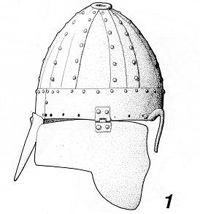
Roman helmet called Der-El Medineh, six conical sectors held by rivets rounded, had protection for the nose, neck and ears.
Category: Spangenhelmen
The original is in Cairo, the Egyptian Museum, can probably be dated between the 4th and 5th centuries
 Attachment: 75.05 KB Attachment: 75.05 KB
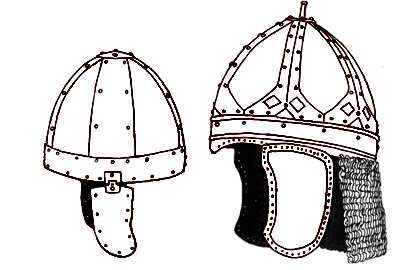
type-Spangenhelmen Baldenheim comes from the Germanic tribe Gepids depicted in the first part of the sixth century, this was allocated in the area of Belgrade.
The type-Spangenhelmen Baldenheim shown is derived from the Germanic tribes Gepids
 Attachment: 157.07 KB Attachment: 157.07 KB
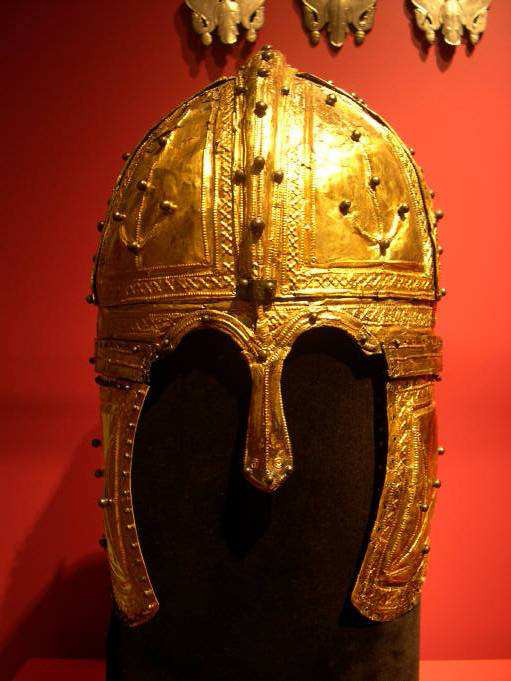
Perhaps the most famous Spangenhelmen
Ciao
Maurizio
Last edited by Maurizio D'Angelo on Fri 05 Nov, 2010 1:55 am; edited 3 times in total
|
|
   |
 |
|
Raino S
|
 Posted: Fri 05 Nov, 2010 1:50 am Post subject: Posted: Fri 05 Nov, 2010 1:50 am Post subject: |
 |
|
| Maurizio D'Angelo wrote: | | Perhaps the most famous Spangenhelmen |
they are all from the 6th century. i'm looking for the later variants. possibly from 8-11th century.
|
|
  |
 |
Maurizio D'Angelo

|
 Posted: Fri 05 Nov, 2010 2:19 am Post subject: Posted: Fri 05 Nov, 2010 2:19 am Post subject: |
 |
|
I guess you need a helmet Norman
In this case, has already responded, Chad. 
Ciao
Maurizio
|
|
   |
 |
|
Stephen Curtin
|
 Posted: Fri 05 Nov, 2010 4:25 am Post subject: Posted: Fri 05 Nov, 2010 4:25 am Post subject: |
 |
|
I have been wondering lately, why were the cheek and neck guards of early spangenhelm not present on later examples?
I know that there are many examples of earlier spangenhelm and only example from the viking period, but what other evidence is there to show that cheek and neck guards were not present on later helmets
Éirinn go Brách
|
|
   |
 |
|
Raino S
|
 Posted: Fri 05 Nov, 2010 5:23 am Post subject: Posted: Fri 05 Nov, 2010 5:23 am Post subject: |
 |
|
| Stephen Curtin wrote: | I have been wondering lately, why were the cheek and neck guards of early spangenhelm not present on later examples?
I know that there are many examples of earlier spangenhelm and only example from the viking period, but what other evidence is there to show that cheek and neck guards were not present on later helmets |
pictorial evidence from works such as the bayeux tapestry.
|
|
  |
 |
Chad Arnow
myArmoury Team


|
 Posted: Fri 05 Nov, 2010 5:53 am Post subject: Posted: Fri 05 Nov, 2010 5:53 am Post subject: |
 |
|
That doesn't appear to be a spangenhelm at all. "Spangen" means something like "plates" so the helm must be made of multiple plates to be a spangenhelm. Most (not all) spangenhelms have the plates riveted to a frame of some sort. I do know of one example without a frame, where the plates are riveted to each other.

ChadA
http://chadarnow.com/
|
|
    |
 |
Jean Thibodeau

|
 Posted: Fri 05 Nov, 2010 6:05 am Post subject: Posted: Fri 05 Nov, 2010 6:05 am Post subject: |
 |
|
Nasal helms are at times spangenhelms but at other times raised in one piece with the nasal being either part of the raised plate or a separate piece: In general look the " Norman " nasal helms tend to be called spangenhelm by error as Chad mentioned.
You can easily give up your freedom. You have to fight hard to get it back!
|
|
  |
 |
|
Raino S
|
 Posted: Fri 05 Nov, 2010 6:20 am Post subject: Posted: Fri 05 Nov, 2010 6:20 am Post subject: |
 |
|
| Chad Arnow wrote: |
That doesn't appear to be a spangenhelm at all. "Spangen" means something like "plates" so the helm must be made of multiple plates to be a spangenhelm. Most (not all) spangenhelms have the plates riveted to a frame of some sort. I do know of one example without a frame, where the plates are riveted to each other. |
i was thinking about this helm:


but on second look, it only has a single band running from front to back, making it a "bandhelme"
|
|
  |
 |
|
Raino S
|
 Posted: Fri 05 Nov, 2010 6:48 am Post subject: Posted: Fri 05 Nov, 2010 6:48 am Post subject: |
 |
|
here, i made another picture:

segmented helms has been found. bandhelme has been found.
has there ever been found a norman nasal spangenhelm though?
|
|
  |
 |
Chad Arnow
myArmoury Team


|
 Posted: Fri 05 Nov, 2010 12:29 pm Post subject: Posted: Fri 05 Nov, 2010 12:29 pm Post subject: |
 |
|
I've never heard of a bandehelm. That's a new term for me. It just looks like a spangehelm with a less involved frame. Since it's still made up of pieces, "spangenhelm" is still an appropriate term, right?
Most spangenhelms seem to date from earlier than the centuries you're looking for. But here is one dated 8th-10th century. As of the late 1970s, it was on loan to the Tower of London from the Liverpool Museum.
 Attachment: 58.72 KB Attachment: 58.72 KB
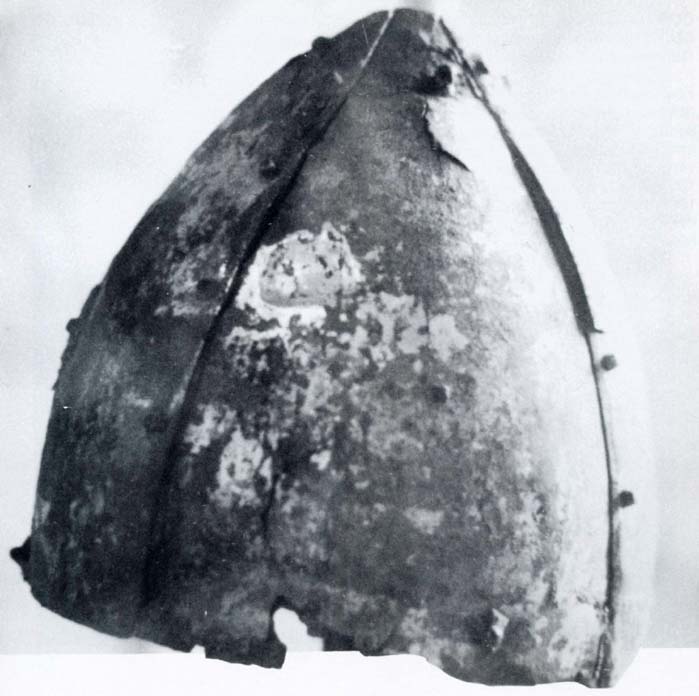
 Attachment: 50.91 KB Attachment: 50.91 KB
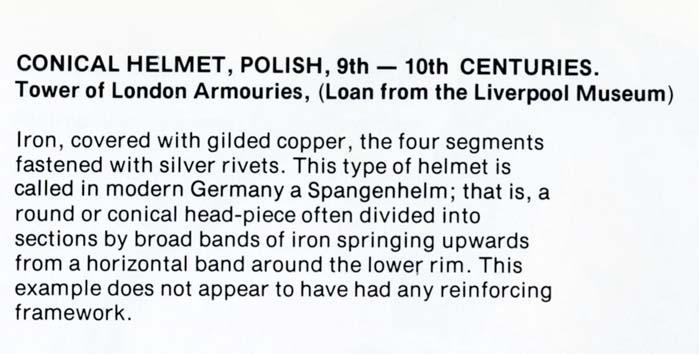

ChadA
http://chadarnow.com/
|
|
    |
 |
|
Patrick Kelly
|
 Posted: Fri 05 Nov, 2010 2:54 pm Post subject: Posted: Fri 05 Nov, 2010 2:54 pm Post subject: |
 |
|
Here's an old photo of one, provence unknown.

"In valor there is hope.".................. Tacitus
|
|
   |
 |
|
Raino S
|
 Posted: Fri 05 Nov, 2010 3:17 pm Post subject: Posted: Fri 05 Nov, 2010 3:17 pm Post subject: |
 |
|
| Chad Arnow wrote: | I've never heard of a bandehelm. That's a new term for me. It just looks like a spangehelm with a less involved frame. Since it's still made up of pieces, "spangenhelm" is still an appropriate term, right?
|
"spangen" specifically refer to the metal strip framework that the helmet plates are bolted onto.
the picture you posted is of a segmented helm, where the helmet plates are bolted directly together, without any "spangens".
|
|
  |
 |
|
Raino S
|
 Posted: Fri 05 Nov, 2010 3:18 pm Post subject: Posted: Fri 05 Nov, 2010 3:18 pm Post subject: |
 |
|
| Patrick Kelly wrote: | | Here's an old photo of one, provence unknown. |
thanks, thats exactly what i was looking for.
|
|
  |
 |
Chad Arnow
myArmoury Team


|
 Posted: Fri 05 Nov, 2010 8:10 pm Post subject: Posted: Fri 05 Nov, 2010 8:10 pm Post subject: |
 |
|
| Raino S wrote: | "spangen" specifically refer to the metal strip framework that the helmet plates are bolted onto.
the picture you posted is of a segmented helm, where the helmet plates are bolted directly together, without any "spangens". |
Please know that your definition is not the only one out there and a number of people may not agree with it. David Edge and John Miles Paddock say this about the spangenhelm in Arms & Armor of the Medieval Knight:
In their glossary, they define a spangenhelm as:
| Quote: | | A modern German term describing conical helmets constructed of a number of segments riveted together; descended from Late Roman prototypes. |
In the text of the book, they state:
| Quote: | | The Spangenhelm was at first constructed of three pieces, consisting of two half skulls riveted to a central comb, but later examples consisted of an iron framework of ribs extending from a brow band converging at the apex of the helmet. |
So the first sentence describes what you call a bandhelme.
Many (most) people and publications I know of use the term spangenhelm to cover the family of helms that includes your bandhelme, spangenhelm, and segmented helm. That's why you're getting pictures of things you're not expecting. 

ChadA
http://chadarnow.com/
|
|
    |
 |
|
Raino S
|
 Posted: Sat 06 Nov, 2010 1:00 am Post subject: Posted: Sat 06 Nov, 2010 1:00 am Post subject: |
 |
|
| Chad Arnow wrote: | | Raino S wrote: | "spangen" specifically refer to the metal strip framework that the helmet plates are bolted onto.
the picture you posted is of a segmented helm, where the helmet plates are bolted directly together, without any "spangens". |
Please know that your definition is not the only one out there and a number of people may not agree with it. David Edge and John Miles Paddock say this about the spangenhelm in Arms & Armor of the Medieval Knight:
In their glossary, they define a spangenhelm as:
| Quote: | | A modern German term describing conical helmets constructed of a number of segments riveted together; descended from Late Roman prototypes. |
In the text of the book, they state:
| Quote: | | The Spangenhelm was at first constructed of three pieces, consisting of two half skulls riveted to a central comb, but later examples consisted of an iron framework of ribs extending from a brow band converging at the apex of the helmet. |
So the first sentence describes what you call a bandhelme.
Many (most) people and publications I know of use the term spangenhelm to cover the family of helms that includes your bandhelme, spangenhelm, and segmented helm. That's why you're getting pictures of things you're not expecting.  |
ok. i picked the bandhelme term up from hermann historica, and a book also mentioned bandhelme.
it seems to be used by roman era historians to distinguish the germannic spangenhelme with multiple metal strips, from a roman spangenhelm with a single metal strip.
i think its a nice way to distinguish the different variations of segmented helms.
|
|
  |
 |
|
|

